In Affluent Southampton, the Grave Protection Warrior Society Toils to Preserve and Protect Ancestral Homelands
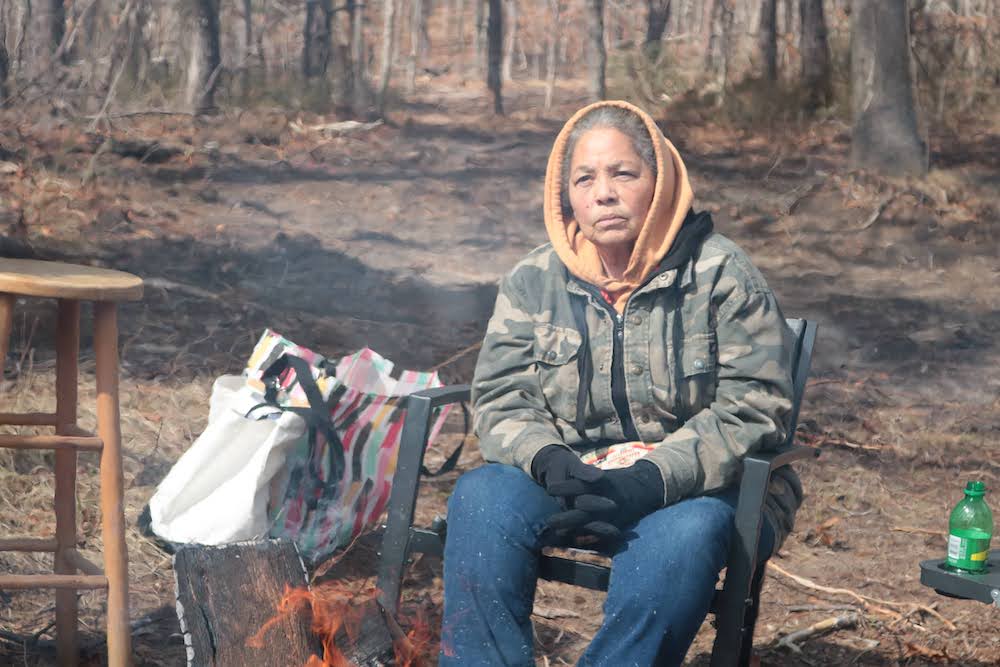
Becky Genia (Shinnecock) sits in protest on a property in Southampton, New York on Sunday, March 27, 2022.
(Photo: Evan Mills)
A changing landscape
On the east end of Long Island, New York in the town of Southampton—an area of seven villages that consistently ranks among the most expensive area codes in the United State—the Shinnecock Nation has been up against old money, and the power it holds, for generations.
When settlers arrived on the Shinnecock Nation’s shores in 1640, the Nation eventually gave the newcomers a swath of land to live on. But the settlers wanted more–and eventually stole everything but 3,600 acres of land from their new neighbors. In 1703, the town offered the Shinnecock a thousand-year lease to live on those 3,600 acres in an area known as the Shinnecock Hills in Southampton, but later broke that lease by falsifying records in 1859.
Since 1859, the Shinnecock Nation territory has been reduced by nearly 80 percent and moved to lower land on a peninsula on the island’s south shore.
But the tribe’s ancestral burial grounds remained in Shinnecock Hills, an area with the town of Southampton so beautiful that everyone wants a piece of it: business owners, developers, homeowners—there’s even four golf courses within the traditional territory. Over the years, all but 250 acres of available land in Shinnecock Hills has been purchased and developed by private citizens, Genia said.
Those who grew up in Southampton have watched it transform as more and more trees are unearthed to make way for another mansion.
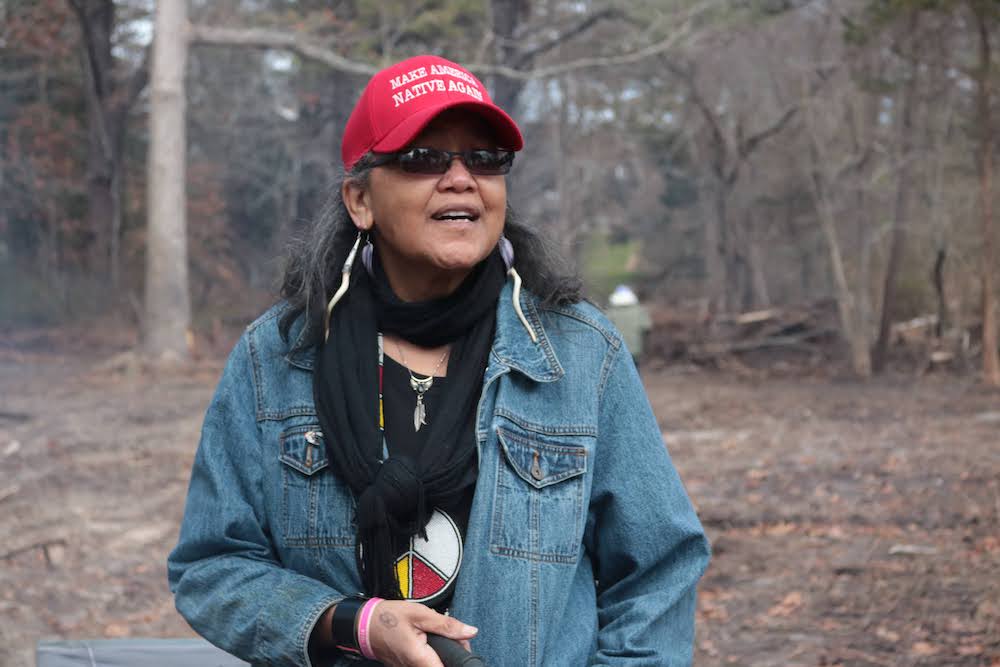
The light at the end of the tunnel
Over the last 30 years, the inter-tribal task force of grave protectors has successfully protected about 50 acres of land in their traditional territory, and returned almost 300 ancestors to their homes.
Another big win came last summer, when a land trust working with the tribe–and supported by a $300,000 contribution from Roger Waters of the rock band Pink Floyd—bought back the most sacred of the land within the hills, Sugar Loaf Hills.
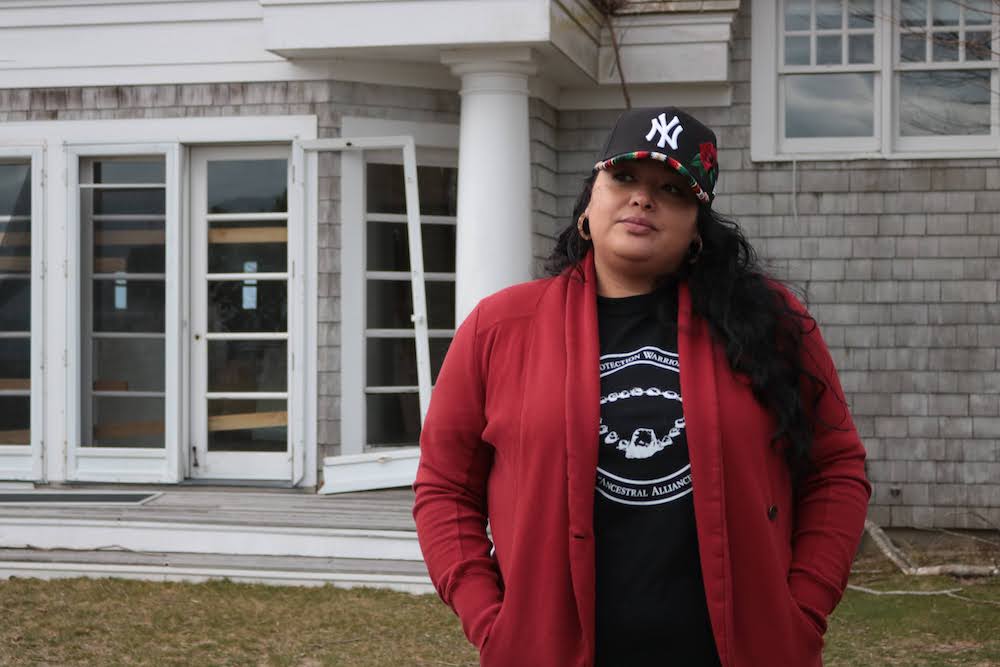
About The Author

Jenna Kunze
Staff Writer
Jenna Kunze is a reporter for Native News Online and Tribal Business News. Her bylines have appeared in The Arctic Sounder, High Country News, Indian Country Today, Smithsonian Magazine and Anchorage Daily News. In 2020, she was one of 16 U.S. journalists selected by the Pulitzer Center to report on the effects of climate change in the Alaskan Arctic region. Prior to that, she served as lead reporter at the Chilkat Valley News in Haines, Alaska. Kunze is based in New York.
BY JENNA KUNZE
APRIL 02, 2022
Indigenous grave protectors in Long Island say their town—among the wealthiest zip codes in the United States—isn’t doing enough to protect their buried ancestors, despite a Southampton fund specifically dedicated to buying land for preservation.
NEW YORK — As a kid growing up on the Shinnecock Indian Nation in the 1960s, Becky Genia didn’t visit amusement parks and playgrounds like other kids her age. Instead, Genia’s grandmother took her and her brother to cemeteries.
“It was our regular thing, our outing, going to cemeteries,” Genia, 65, said. “To me, what she instilled in us was the importance of unmarked burials and visiting the dead and communicating. She passed away when I was 17 so it was like, ‘you better learn it now, girl, ‘cause I’m not here for long.’”
Genia did learn it and, decades later, she lives it.
Indigenous grave protectors in Long Island say their town—among the wealthiest zip codes in the United States—isn’t doing enough to protect their buried ancestors, despite a Southampton fund specifically dedicated to buying land for preservation.
NEW YORK — As a kid growing up on the Shinnecock Indian Nation in the 1960s, Becky Genia didn’t visit amusement parks and playgrounds like other kids her age. Instead, Genia’s grandmother took her and her brother to cemeteries.
“It was our regular thing, our outing, going to cemeteries,” Genia, 65, said. “To me, what she instilled in us was the importance of unmarked burials and visiting the dead and communicating. She passed away when I was 17 so it was like, ‘you better learn it now, girl, ‘cause I’m not here for long.’”
Genia did learn it and, decades later, she lives it.
A changing landscape
On the east end of Long Island, New York in the town of Southampton—an area of seven villages that consistently ranks among the most expensive area codes in the United State—the Shinnecock Nation has been up against old money, and the power it holds, for generations.
When settlers arrived on the Shinnecock Nation’s shores in 1640, the Nation eventually gave the newcomers a swath of land to live on. But the settlers wanted more–and eventually stole everything but 3,600 acres of land from their new neighbors. In 1703, the town offered the Shinnecock a thousand-year lease to live on those 3,600 acres in an area known as the Shinnecock Hills in Southampton, but later broke that lease by falsifying records in 1859.
Since 1859, the Shinnecock Nation territory has been reduced by nearly 80 percent and moved to lower land on a peninsula on the island’s south shore.
But the tribe’s ancestral burial grounds remained in Shinnecock Hills, an area with the town of Southampton so beautiful that everyone wants a piece of it: business owners, developers, homeowners—there’s even four golf courses within the traditional territory. Over the years, all but 250 acres of available land in Shinnecock Hills has been purchased and developed by private citizens, Genia said.
Those who grew up in Southampton have watched it transform as more and more trees are unearthed to make way for another mansion.

Jennifer Cuffee-Wilson was born and raised on the Shinnecock Reservation in Southampton. She says that her parents wouldn't recognize the town anymore due to over development. (Photo: Evan Mills)
“My father would not recognize this place,” said 62-year-old Jennifer Cuffee-Wilson, donning a red baseball hat that reads Make America Native Again. “My mother, though she passed away in 2006, would not recognize this place, because every open space that there is (being developed). It’s heartbreaking because before 1640, this place was just gorgeous.
For decades now, an inter-tribal coalition with representation from at least 17 tribes has been working to preserve and protect their ancestral homelands from over development. The list includes Cree, Cherokee, Lenape, Matinecock, Mohegan, Matinecock, Montaukett, Pequot, Naragansett Setaukett, Nipmuk, Ojibway, Pequot, Unkechaug, Santee Sioux, Shinnecock, Ramapough Lenape, and Wampanoag people.
‘The eyes are on the hills’
Last Sunday, about a dozen cars lined up on the side of the Montauk Highway, a road bisecting Shinnecock land that was built in the ‘60s to make the Hamptons more accessible from New York City. One of the cars sported a bumper sticker that read: “I’m Shinnecock, what’s your superpower?” Genia’s van had a Ghostbusters sticker on its side.
Behind the cars, staked out on an undeveloped plot of land recently cleared of its trees, tribal members and allies gathered around a fire pit in folding chairs and on benches that sat askew on uneven ground.
The Grave Protection Warrior Society, as most of those gathered around the fire call themselves, has been here most Sundays for the last month and a half. Sometimes they hold signs to alert passing drivers of their mission—to preserve and protect their sacred lands. Sometimes they simply sit and hold watch to prevent any further disturbance of their ancestral burial grounds. When passing cars beep in support, everyone from the group turns from their conversation and waves towards the street.
The Town of Southampton in 2020 finally responded to the tribal coalition’s ask when it passed a protection of unmarked graves law for the first time. As written, the law establishes procedures for identifying unmarked human burial sites and culturally sensitive archeological sites prior to certain types of development.
Tribal members say the law still falls short of protecting the area’s unmarked graves.
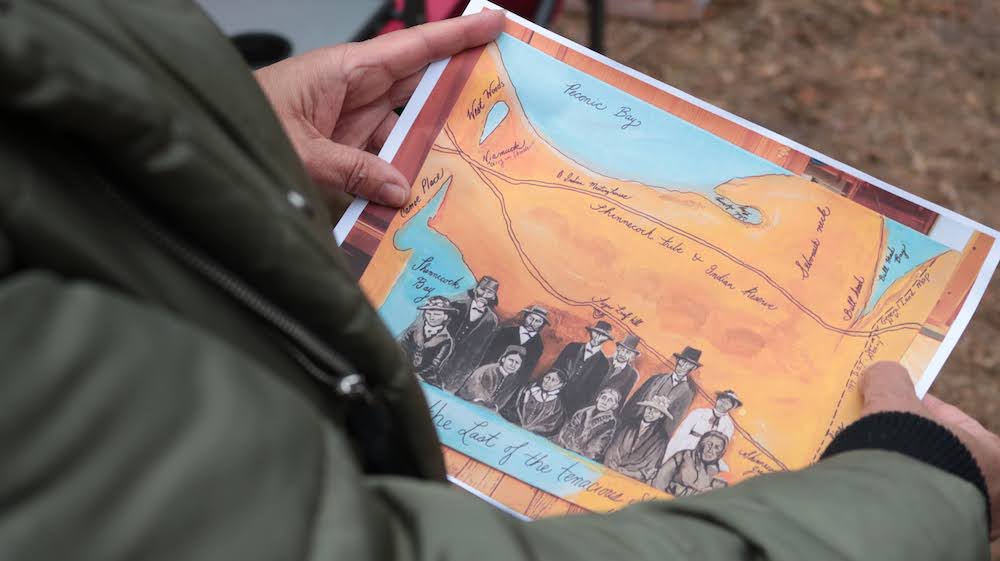
“My father would not recognize this place,” said 62-year-old Jennifer Cuffee-Wilson, donning a red baseball hat that reads Make America Native Again. “My mother, though she passed away in 2006, would not recognize this place, because every open space that there is (being developed). It’s heartbreaking because before 1640, this place was just gorgeous.
For decades now, an inter-tribal coalition with representation from at least 17 tribes has been working to preserve and protect their ancestral homelands from over development. The list includes Cree, Cherokee, Lenape, Matinecock, Mohegan, Matinecock, Montaukett, Pequot, Naragansett Setaukett, Nipmuk, Ojibway, Pequot, Unkechaug, Santee Sioux, Shinnecock, Ramapough Lenape, and Wampanoag people.
‘The eyes are on the hills’
Last Sunday, about a dozen cars lined up on the side of the Montauk Highway, a road bisecting Shinnecock land that was built in the ‘60s to make the Hamptons more accessible from New York City. One of the cars sported a bumper sticker that read: “I’m Shinnecock, what’s your superpower?” Genia’s van had a Ghostbusters sticker on its side.
Behind the cars, staked out on an undeveloped plot of land recently cleared of its trees, tribal members and allies gathered around a fire pit in folding chairs and on benches that sat askew on uneven ground.
The Grave Protection Warrior Society, as most of those gathered around the fire call themselves, has been here most Sundays for the last month and a half. Sometimes they hold signs to alert passing drivers of their mission—to preserve and protect their sacred lands. Sometimes they simply sit and hold watch to prevent any further disturbance of their ancestral burial grounds. When passing cars beep in support, everyone from the group turns from their conversation and waves towards the street.
The Town of Southampton in 2020 finally responded to the tribal coalition’s ask when it passed a protection of unmarked graves law for the first time. As written, the law establishes procedures for identifying unmarked human burial sites and culturally sensitive archeological sites prior to certain types of development.
Tribal members say the law still falls short of protecting the area’s unmarked graves.

'Not the last of the tenacious Shinnecock' art by tribal member and grave protector Denise Silva-Dennis. (Photo: Evan Mills)
The law recognizes the “sanctity of burial sites of individuals interred within [the] town” and acknowledged the Shinnecock Nation as having unmarked graves. It establishes a joint committee between the town and tribal members to consult prior to development on culturally sensitive lands. Importantly, it also “codifies the towns willingness” to explore the acquisition of sensitive properties through the Community Preservation Fund, a program that works to preserve town lands by buying it off willing landowners.
There is, of course, a loophole: private land owners don’t need a permit to clear land before development, which means the joint committee isn’t notified prior to activity. That is the case at 501 Montauk, a mostly barren 1.5-acre lot on the side of the highway that’s become the latest focus of The Grave Protection Warriors.
“They didn’t notify us,” Genia said from her lawn chair on the newly cleared property last Sunday. The fact that the trees were cleared from the lot, she notes, could have disturbed any buried remains or artifacts. “It’s just another slap in the face because they continuously do it, and even though (the town) says they’re working with us, behind closed doors they (don’t).”
The property is particularly sensitive to the Shinnecock. Two years ago, builders laying the foundation at a neighboring property cordoned off a small section and drew a skull and crossbones over it.
“It was crazy–we didn’t know what to make of it,” Genia said. “Of course, we think we know what we made of it: they wanted to relay this message to us, that they found (human remains) without getting fired.”
It wouldn’t have been the first time human remains were unearthed in the area: In 2003, a developer on Shelter Island, off the coast of Long Island, unearthed a mass Native burial site on his property, then built a horse barn over the site. A human skull and many Native artifacts were discovered in nearby Water Mill in 2006. In 2018, Native American skeleton remains were found during residential development in the Shinnecock Hills.
In response, Graves Protectors held a protest to ask the town of Southampton to intervene and stop work on the property in response to the obvious message.
“We came out here in freezing cold January with about 150 people and said: ‘no more’,” Genia said. “I guess with that attention, the town said, ‘Okay, well, they have all their permits, but we'll preserve what's around (the property).’”
The protectors assumed the neighboring property was included in the town’s promise to preserve. “But, as you can tell, we were dead wrong,” Genia said.
The group returned again every Sunday since mid-February, when they saw that the empty lot had been disturbed. Their increased presence and media attention has bought them traction in recent years. “ I think that’s why anything is getting preserved at all,” Genia said. “The eyes are on the hills.”
Also present at the protest was Town of Southampton’s recently resigned archaeologist, JoAnn McClean. McClean was hired last year as a result of the town’s new grave protection legislation.
“I was basically hired in order to react to and lead the town through any inadvertent uncovering of human remains,” McClean said. “I think, in reality, I was hired to appease Shinnecock, for someone to kind of take the heat if Native American remains were dug up.”
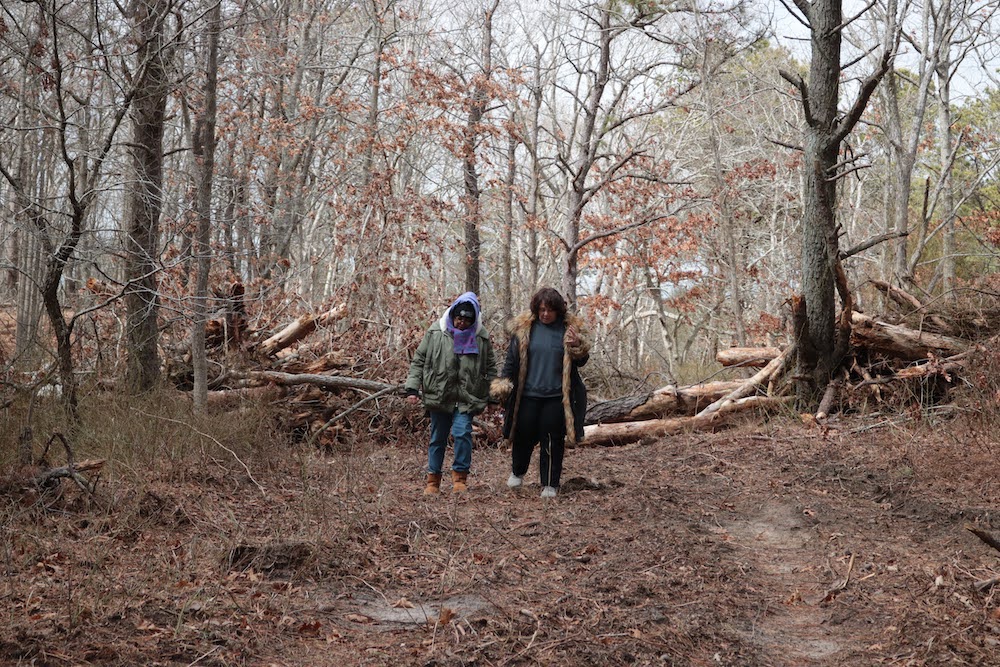
The law recognizes the “sanctity of burial sites of individuals interred within [the] town” and acknowledged the Shinnecock Nation as having unmarked graves. It establishes a joint committee between the town and tribal members to consult prior to development on culturally sensitive lands. Importantly, it also “codifies the towns willingness” to explore the acquisition of sensitive properties through the Community Preservation Fund, a program that works to preserve town lands by buying it off willing landowners.
There is, of course, a loophole: private land owners don’t need a permit to clear land before development, which means the joint committee isn’t notified prior to activity. That is the case at 501 Montauk, a mostly barren 1.5-acre lot on the side of the highway that’s become the latest focus of The Grave Protection Warriors.
“They didn’t notify us,” Genia said from her lawn chair on the newly cleared property last Sunday. The fact that the trees were cleared from the lot, she notes, could have disturbed any buried remains or artifacts. “It’s just another slap in the face because they continuously do it, and even though (the town) says they’re working with us, behind closed doors they (don’t).”
The property is particularly sensitive to the Shinnecock. Two years ago, builders laying the foundation at a neighboring property cordoned off a small section and drew a skull and crossbones over it.
“It was crazy–we didn’t know what to make of it,” Genia said. “Of course, we think we know what we made of it: they wanted to relay this message to us, that they found (human remains) without getting fired.”
It wouldn’t have been the first time human remains were unearthed in the area: In 2003, a developer on Shelter Island, off the coast of Long Island, unearthed a mass Native burial site on his property, then built a horse barn over the site. A human skull and many Native artifacts were discovered in nearby Water Mill in 2006. In 2018, Native American skeleton remains were found during residential development in the Shinnecock Hills.
In response, Graves Protectors held a protest to ask the town of Southampton to intervene and stop work on the property in response to the obvious message.
“We came out here in freezing cold January with about 150 people and said: ‘no more’,” Genia said. “I guess with that attention, the town said, ‘Okay, well, they have all their permits, but we'll preserve what's around (the property).’”
The protectors assumed the neighboring property was included in the town’s promise to preserve. “But, as you can tell, we were dead wrong,” Genia said.
The group returned again every Sunday since mid-February, when they saw that the empty lot had been disturbed. Their increased presence and media attention has bought them traction in recent years. “ I think that’s why anything is getting preserved at all,” Genia said. “The eyes are on the hills.”
Also present at the protest was Town of Southampton’s recently resigned archaeologist, JoAnn McClean. McClean was hired last year as a result of the town’s new grave protection legislation.
“I was basically hired in order to react to and lead the town through any inadvertent uncovering of human remains,” McClean said. “I think, in reality, I was hired to appease Shinnecock, for someone to kind of take the heat if Native American remains were dug up.”

On Sunday, March 27, Shinnecock tribal member and grave protector Denise Silva-Dennis (left) walks beside Southampton's recently resigned archaeologist, JoAnn Mclean, to survey land disturbed within the sacred Shinnecock Hills.
(Photo: Evan Mills)
McClean said she resigned her position at the end of February because she didn’t feel she was being treated with respect, or effectively able to get the town to agree to proactive measures to protect graves, rather than reactive measures.
“What I pushed for, but I couldn't get, was that the town be proactive as far as seeking out land owners, in offering them a reasonable amount of money to purchase and preserve their land before they get to that point (of land clearing),” she said.
‘The bottom line’
The Grave Protection Warriors’ main request is for the town to use its Community Preservation Fund to buy up the remaining available land in the hills for preservation. The cost, at roughly a million dollars an acre, would be $250 million.
Land preservation is a win-win for everyone in Southampton, McClean said.
“You can't find one thing that's wrong with it,” she said. “If you keep tearing down trees and putting up mcMansions, no one will want to come out here anymore because it will lose all of its charm. So preservation is only a good thing for everybody.”
The preservation fund, which is paid for by a 2 percent real estate transfer tax, has generated more than $9 million since its inception in 1999. It has spent roughly $7 million on its purchases, according to a 2020 report on the town’s website. Native News Online filed a Freedom of Information Act to find out the exact balance of the Community Preservation Fund, but did not hear back by the time of publication.
“If the town is willing to purchase land after the fact, after someone has pulled down the trees, why wouldn't they be willing to go in there proactively approach the owners and say, ‘We want to buy your land’?” McClean said. “Why wait for the Shinnecock to protest?”
According to Southampton Town Attorney James Burke, the town reached out to the 501 Montauk property landowner back in 2018, but there was no interest in selling the property at the time. Now that the landowner for the property has put out a for sale sign, the town’s Community Preservation Fund has reached out once again to express interest in the sale.
“If we can buy this, we’re taking every step within our power to try to do that,” Burke said. “We can’t force owners to sell.”
The next step, according to Community Preservation Fund Director Lisa Kombrink, is to wait on a property appraisal. From there, the town board must decide on the offer, and the seller must accept. When the town acquires a property for preservation purposes, she added, it stays with the town.
McClean said she resigned her position at the end of February because she didn’t feel she was being treated with respect, or effectively able to get the town to agree to proactive measures to protect graves, rather than reactive measures.
“What I pushed for, but I couldn't get, was that the town be proactive as far as seeking out land owners, in offering them a reasonable amount of money to purchase and preserve their land before they get to that point (of land clearing),” she said.
‘The bottom line’
The Grave Protection Warriors’ main request is for the town to use its Community Preservation Fund to buy up the remaining available land in the hills for preservation. The cost, at roughly a million dollars an acre, would be $250 million.
Land preservation is a win-win for everyone in Southampton, McClean said.
“You can't find one thing that's wrong with it,” she said. “If you keep tearing down trees and putting up mcMansions, no one will want to come out here anymore because it will lose all of its charm. So preservation is only a good thing for everybody.”
The preservation fund, which is paid for by a 2 percent real estate transfer tax, has generated more than $9 million since its inception in 1999. It has spent roughly $7 million on its purchases, according to a 2020 report on the town’s website. Native News Online filed a Freedom of Information Act to find out the exact balance of the Community Preservation Fund, but did not hear back by the time of publication.
“If the town is willing to purchase land after the fact, after someone has pulled down the trees, why wouldn't they be willing to go in there proactively approach the owners and say, ‘We want to buy your land’?” McClean said. “Why wait for the Shinnecock to protest?”
According to Southampton Town Attorney James Burke, the town reached out to the 501 Montauk property landowner back in 2018, but there was no interest in selling the property at the time. Now that the landowner for the property has put out a for sale sign, the town’s Community Preservation Fund has reached out once again to express interest in the sale.
“If we can buy this, we’re taking every step within our power to try to do that,” Burke said. “We can’t force owners to sell.”
The next step, according to Community Preservation Fund Director Lisa Kombrink, is to wait on a property appraisal. From there, the town board must decide on the offer, and the seller must accept. When the town acquires a property for preservation purposes, she added, it stays with the town.
The light at the end of the tunnel
Over the last 30 years, the inter-tribal task force of grave protectors has successfully protected about 50 acres of land in their traditional territory, and returned almost 300 ancestors to their homes.
Another big win came last summer, when a land trust working with the tribe–and supported by a $300,000 contribution from Roger Waters of the rock band Pink Floyd—bought back the most sacred of the land within the hills, Sugar Loaf Hills.

Bianca Collins, an active member of the Graves Protection Warriors, explains the Nation's recent success in getting back its most sacred burial site within the Shinnecock Hills where chiefs are buried. In July, the Peconic Land Trust closed on the $5.6 million purchase of the 4.5-acre parcel in Shinnecock Hills, called Sugar Loaf Hill. It's the first time tribal residents have had access to the land since 1859. (Photo: Evan Mills)
“We knew all our lives that the chiefs of our tribe were buried on Sugar Loaf because it was the highest point of our ancestral territory, and that's how they could look out for us after death,” Genia said.
Growing up, Genia’s grandmother would drive past Sugar Loaf to show her grandkids where their chiefs were buried, though “she was only able to point to it from the highway, because it was private property,” Genia recalls.
In the last two years alone, the group has reclaimed more than 150 human remains that had been unearthed by archeologists and museums in Suffolk County in the late 1800s and early 1900s.
Genia says it’s not enough.
“Our goal is to get every ancestor back from the cemeteries and institutions, no matter where they are,” she said.
Genia has built her life around honoring not only her ancestors, but her descendants. She’s a mother, grandmother, and great grandmother.
Everyone wants to think that the Ghostbusters sticker on the side of her van is for her graves protection work—and it doubles as such, she says— but really it's to meet the request of her 20-year-old grandson that she’s brought up as her son. He loves Ghostbusters, and she’s determined to protect each ancestor’s eternal resting place.
“If you're looking for a light at the end of the tunnel, it’s this,” she says, surrounded by her great grandchildren. “We're not going to stop fighting. I have all these kids, grandkids, great grandkids, they are my world, my life. I want to bring them up in a way that I was brought up, to honor my ancestors. That's what I'm gonna pass down to these children.”
“We knew all our lives that the chiefs of our tribe were buried on Sugar Loaf because it was the highest point of our ancestral territory, and that's how they could look out for us after death,” Genia said.
Growing up, Genia’s grandmother would drive past Sugar Loaf to show her grandkids where their chiefs were buried, though “she was only able to point to it from the highway, because it was private property,” Genia recalls.
In the last two years alone, the group has reclaimed more than 150 human remains that had been unearthed by archeologists and museums in Suffolk County in the late 1800s and early 1900s.
Genia says it’s not enough.
“Our goal is to get every ancestor back from the cemeteries and institutions, no matter where they are,” she said.
Genia has built her life around honoring not only her ancestors, but her descendants. She’s a mother, grandmother, and great grandmother.
Everyone wants to think that the Ghostbusters sticker on the side of her van is for her graves protection work—and it doubles as such, she says— but really it's to meet the request of her 20-year-old grandson that she’s brought up as her son. He loves Ghostbusters, and she’s determined to protect each ancestor’s eternal resting place.
“If you're looking for a light at the end of the tunnel, it’s this,” she says, surrounded by her great grandchildren. “We're not going to stop fighting. I have all these kids, grandkids, great grandkids, they are my world, my life. I want to bring them up in a way that I was brought up, to honor my ancestors. That's what I'm gonna pass down to these children.”
About The Author

Jenna Kunze
Staff Writer
Jenna Kunze is a reporter for Native News Online and Tribal Business News. Her bylines have appeared in The Arctic Sounder, High Country News, Indian Country Today, Smithsonian Magazine and Anchorage Daily News. In 2020, she was one of 16 U.S. journalists selected by the Pulitzer Center to report on the effects of climate change in the Alaskan Arctic region. Prior to that, she served as lead reporter at the Chilkat Valley News in Haines, Alaska. Kunze is based in New York.
No comments:
Post a Comment